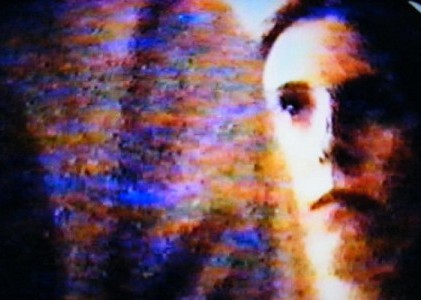Ghosts in the Machine
There once was a time not so long ago when at the appointed hour the cathode-ray tube monitors in homes across America would go haywire and be overtaken by a cool and commanding voice, warning folks away from their dials: “There is nothing wrong with your television set. Do not attempt to adjust the picture. We are controlling transmission…” So opened the 1960s sci-fi series The Outer Limits, which like its predecessor The Twilight Zone played upon widespread anxiety in a fearful postwar world. With technological change speeding forward, perhaps toward annihilation, the future of humankind seemed doubtful. In a world newly wakened to the ruthlessness of totalitarianism, individual agency seemed precarious.
The shows also refracted the idealization of the domestic realm as an impermeable nest for the incubating nuclear family. What did this hygienic space do but tempt contamination? Outer Limits and Twilight Zone episodes often featured monsters and aliens and aggressive science shattering a rosy small town idyll, by extension inviting the bizarre and macabre into viewers’ homes and minds. The portrayal of television as a window into another dimension or state of consciousness, at the bequest of some unseen force, was predicated on the mystery of television’s mechanics, intercepting invisible signals from the sky and conjuring figures and landscapes from fields of static.
Two decades later humankind was still around, though mired in a filthy existence in which the fantasy of domestic stability had been permanently breached. David Cronenberg’s Videodrome (1983) opens in the rancid apartment of a producer for a seedy cable company. No content is sleazy enough for this divining rod of smut, until he happens upon a torture-porn show called Videodrome. Unbeknownst to him, the show has an embedded signal that controls his mind. Under Videodrome’s influence, the producer Max has intense hallucinations of a corporeal experience of television; the TV hardware becomes a permeable sensory organ, hallucinated as the embodiment of Max’s girlfriend. Their charged sadomasochistic relationship is essentially a contest of domination between human and machine, though where the ’60s-era Outer Limits depicted a one-way submission of the viewer to the whims of an autocrat, Videodrome implicates the viewer as a (somewhat) willing partner.
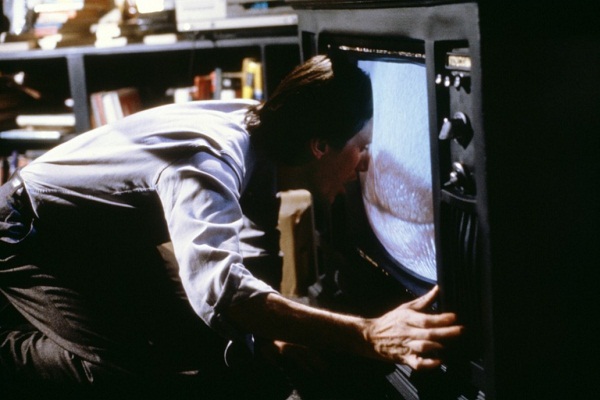
James Woods in Videodrome, directed by David Cronenberg
The extreme of “the video word made flesh” is realized when Max develops a vaginal slit in his abdomen, turning him into a human VCR. The videocassette recorder was a new device when Videodrome was released, widely perceived as a threat to the institution of television, as dramatized by the landmark Sony Betamax case. In 1984, the court’s decision in favor of the makers of recording decks was a sea change in how viewers engaged with television. The VCR’s ability to “time-shift” broadcasts made TV watching less governed, more private and interactive; individuals could watch shows on their own schedules, and also use the VCR to view their own self-produced or self-procured content.
Max’s mental and physical involvement, so total that his body becomes a literal extension of his television, is a pun on Marshall McLuhan’s Understanding Media: The Extensions of Man (1964). In this book, which includes his most famous axiom, “the medium is the message,” McLuhan writes about how new media alters individual and social behavior by facilitating different degrees of participation or involvement. McLuhan’s theories are a reference throughout Videodrome, but in the film he is parodied as a frozen oracle, the tweedy Professor Brian O’Blivion who has long since died and exists solely as a series of videotaped monologues played on televisions.
This reflects a general perception by then of McLuhan as an outdated technological determinist, but it also signifies the disconnect between his academic theories and lived experience. The detachment did, however, grant him a perceptive analysis of the peculiar and imperfect technology of cathode-ray tube television, which he described by way of James Joyce’s Finnegan’s Wake (1939):
With TV, the viewer is the screen. He is bombarded with light impulses that James Joyce called the “Charge of the Light Brigade” that imbues his “soulskin with subconscious inklings.” The TV image is visually low in data. The TV image is not a still shot. It is not photo in any sense, but a ceaselessly forming contour of things limned by the scanning-finger. The resulting plastic contour appears by light through, not light on, and the image so formed has the quality of sculpture and icon, rather than of picture.
McLuhan’s bizarre anthropomorphism of television, tinged with anxiety, emphasizes how the awkwardness of analog technology makes it more physically and psychologically engaging, requiring a greater involvement from the viewer to compensate for this technology’s limitations.
From the perspective of our own hybrid, high-definition digital culture, there has been a growing nostalgia for analog video. Enthusiasts wax poetic about the protracted process of loading a bulky tape into a deck, fast-forwarding as the tape heads squeal eerily, or watching images that are bent, faded, glitched, or ghosted from repeat viewings off cheap tape stock. The fetishization of analog blemishes could be compared to the way scratched and badly spliced 16mm film prints invoke underground or grindhouse cinema culture. The porn industry was an early adopter, embracing video distribution when mainstream content providers were still reluctant. As the oozing smuttiness of Videodrome graphically illustrates, by the 1980s the video medium that was born in the 1960s as a new social tool had become associated with personal vices, a tool serving an unwholesome function that countered the recouping of traditional family values.
McLuhan described the tendency of children to sit too close to the television as a sign of their innate desire to become more involved with it. The iconic image from Tobe Hooper and Steven Spielberg’s Poltergeist (1982), of a little girl perched close to a TV set filled with pulsating static, is a perfect illustration. Like the intro to The Outer Limits, the disruption of the broadcast signal to a noisy squall of snow gives the television an ominous presence, identifying it as a point of infiltration, a conduit between public and private space that has the potential to disturb the sanctity of home. This static is also a siren call to the girl, lured by the machine’s mysterious mechanics. Her interaction with it unleashes mayhem.
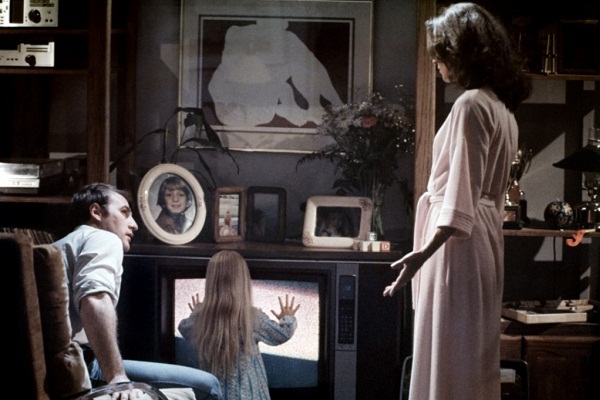
Poltergeist, directed by Tobe Hooper
The erosion of an imagined domestic purity increased rapidly alongside advances in home video. This was not due solely to the technology; the invasion was aided and abetted by the individuals who engage with it. Poltergeist, like McLuhan’s theories, did not yet reflect the home video system that granted users ways to participate beyond being mere “screens.” By the mid to late 1980s, a new participatory relationship to television was being popularized by the marketing of a system of components that included VCR recorders for taping television programs and playing back Hollywood movies, and video camcorders for making home movies. The widespread availability of home video cassettes and recorders fully engendered a personal use of the technology of television, expanding the consumer’s role beyond that of mere receiver to include producer and distributor.
An early manual on home video for the beginner, Bruce Apar and Henry B. Cohen’s The Home Video Book (1982), cheerily details a number of ways that video can “enhance” home life, among them creating video family albums and setting up home security through closed-circuit cameras. These features of video, tools for commemorating family and ensuring its safety, have the exact opposite effect in Henry Joost and Ariel Schulman’s Paranormal Activity 3 (2011). The filmmakers, who grew up in the ’80s, are meticulous with their period specificity. Paranormal looks as if it were assembled from found VHS tapes from 1988, complete with realistic details such as time-code stamps and the blandness of unedited everyday scenes, exploited to infuse familiar banality with dread.
The film’s protagonist and directors’ surrogate happens to be a wedding videographer, and his home is conveniently outfitted with a full editing facility. When strange noises and occurrences start to plague the family, he springs into action, filling the house with tripod-mounted cameras and one crudely improvised mount with an oscillating fan, so the camera swivels in an unbroken pan from open living room to kitchen. Initially, the videographer delights in his project, eagerly retiring to his basement production suite to review footage from the night before. But there is a relation between the videographer’s overzealous documentation and the severity of the paranormal activity, which seems to worsen as he records it, as if it was being conjured by the presence of the cameras.
In her book Reel Families: A Social History of Amateur Film (1995), Patricia Zimmerman outlines how small-gauge film was marketed to encourage amateurs to create pictorial representations of family life. In an expansion of this social history, James Moran’s There’s No Place Like Home Video (2002) notes that while film necessitated a cautious and premeditated approach, the relative inexpensiveness and immediacy of video encouraged different uses altogether. Moran further observes that where Zimmerman demonstrated how home films bolstered the myth of the nuclear family, video cameras left running for hours were more likely to capture the truth of home life, which by conservative standards was dysfunctional. Paranormal Activity is a kind of anti-home movie—in a nutshell, it’s about the dissolution of family. The horror in the film is not a threat from outside, but from what is already there, waiting to be revealed.
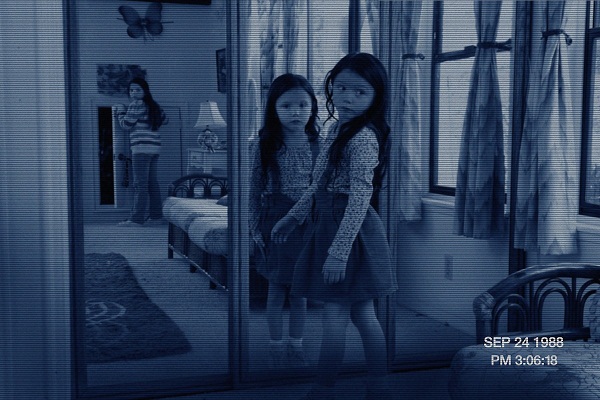
Paranormal Activity 3, directed by Henry Joost and Ariel Schulman
Paranormal Activity 3 could be categorized in the “found footage” horror subgenre, most popularly represented by The Blair Witch Project (1999). An essential aspect of these films is their mimicry of found footage of some supernatural or otherwise unexplainable event, disguising the fabrication of these stories and presenting them as true—furthering a long tradition of bracketing horror stories in claims of veracity. In literature, this would take the form of an objective narrator who simply retells a story that is overheard or passed down. Found footage updates this strategy to the media age, with technology taking the objective narrator’s place.
Specifically, the found VHS tape, the talisman of analog home video, has many qualities that lend it to horror and other dark-themed films about societal abnormalities and deviant behavior. As do the junked film prints of grindhouse cinema, VHS bears the traces of its low-budget production and distribution history. It is an inferior format, having won over the superior Betamax because its lesser quality afforded a longer recording time. It decays and warps easily, as visible in its iconic glitches and disruptions. The standardization of VHS makes it as communicable as a disease, easily circulating content outside governable channels. These are aspects that have been exploited by Hideo Nakata’s Ringu (1998), about a cursed VHS tape, and the forthcoming compendium horror film V/H/S (2012). In these films, the degraded look of video, and its dispersion as found objects of dubious origin, give the black VHS tapes a malevolent agency—though as products of our creation.
David Lynch relates the unmarked VHS tape to repressed memory in Lost Highway (1997), his film about video’s cold ability to record an unvarnished reality. A couple is shaken from their morning routine when a series of tapes arrives on their doorstep, anonymously documenting the exterior of their house. When the tapes begin to show interior views, culminating in intimate footage of the couple sleeping at night, the police are called in. The husband, who will soon be implicated in a dreadful scene caught on one final tape, explains his hatred of home video: “I like to remember things my own way…how I remember them—not necessarily how they happened.”
For the generation that came of age with it, VHS may uniquely function as a repository of the unconscious mind. Several films by 30-something filmmakers have self-reflexively used VHS as a production format, manipulating the now bizarre conventions of analog video and ’80s home video culture to explore a psychological dimension that extends beyond horror genre tropes, while continuing the larger tradition of dark-themed narratives about unsettled home life.
Dustin Defa’s short Family Nightmare (2011) appropriates footage from his family’s trove of home video to create a succinct and disturbing portrait of their dysfunctionality. His chosen scenes are the antithesis of happy home movies—his family is captured partying, abusing substances, and watching porn. Defa removed the original sound and replaced it with his own voice for all the parts, giving the footage an added nightmarish disorientation.
Harmony Korine’s Trash Humpers (2009), shot on VHS, is also a document of abject familial behavior, ostensibly capturing a family of sociopathic perverts who dry hump inanimate objects. Korine deliberately used ’80s-era amateur production and post-production strategies to replicate the look of home video, as he described in an interview with Vulture: “I was very concerned with not making this work like a traditional movie…It needed to approximate a randomness. We were cutting a lot on two VCRs, sometimes blindfolded. So we’d cut in and out of scenes seemingly without reason. I wanted a kind of an incidental awkwardness, like maybe the guy taping it had turned it off and on.”
James Fotopoulos anticipated the current nostalgia for analog video in a series of video features shot and edited on 8mm and VHS, beginning with Jerusalem (2003). Having already worked prodigiously in film, Fotopoulos approached this series with a keen awareness of medium specificity. As he describes it:
Late one evening I entered a convenience store and saw a blank regular 8mm tape on the bottom of a shelf. Immediately the idea hit of this tape lying there like a stone, like an artifact found in a tomb. In my mind a series of images (which would become Jerusalem) unfolded in succession = with this was the idea that all of these images would be shot unfolding before me, as if I was preserving the already dead medium—creating something found. It would be like I went into the past to create what I found in the future and brought it back to the present. As if I jumped forward over the transmission into the antiquatedness of the technology, so my production would take place as if already dead = frozen. So I would shoot it, edit it and have it unfold with all the mistakes, at the fastest execution possible within camera.
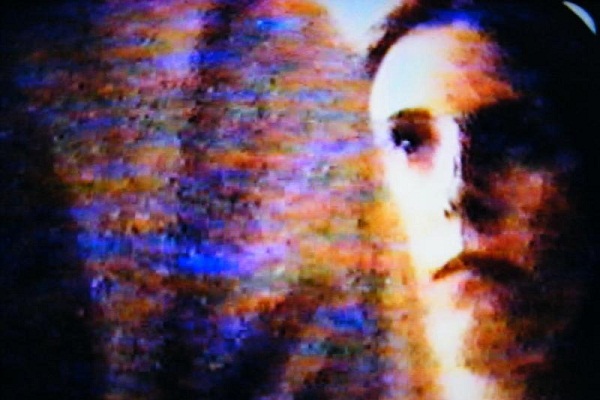
Jerusalem, directed by James Fotopoulos
Like Poltergeist, Jerusalem begins in a wash of static, so grainy it has the physicality of a natural element. Harried voices emerge from the noise, describing a possible alien abduction. Glimpses of a vacant apartment break through to cast these fantastic tales against mundane domesticity. The script for this disquieting feature-length film, which is shorn of identifying credits and other earmarks of narrative filmmaking, is only 11 pages, repeating and layering its strange tales over and over, giving it the pummeling insistence of a hypnotic device for conjuring altered states of consciousness.
But as in The Outer Limits, Jerusalem’s suggestion of ghosts and aliens or other forces controlling the machine is a ruse, a displacement of our real fears. The true terror, unwittingly presaged by McLuhan, is what imperfect, antiquated technology reveals to us of ourselves. The fright of technology run amok is the fear of lost control, and of ruined institutional authority. It is the mortality of these things, mirroring the mortality of our personal institutions of self and family, that makes them most frightening, as they splinter off from our present to become relics of the past, taking our memories with them. The specter that haunts machines is none other than death itself.
On Friday, July 13, as part of its VHS series, the Museum of Art and Design will screen James Fotopoulos’s Jerusalem, preceded by a conversation between Fotopoulos and the author. ![]()
LATEST ARTICLES
-20140814-173707-thumb3.jpg)
Fighting Words
by Imogen Sara Smith
posted August 12, 2014

Fighting Words, Part 2
by Imogen Sara Smith
posted August 20, 2014

On the Margins: The Fil…
by Andrew Chan
posted August 12, 2014

Robin Williams: A Sense…
by David Schwartz
posted August 12, 2014
 Ghosts in the Machine
Ghosts in the Machine
THE AUTHOR
Rebecca Cleman is the Director of Distribution of Electronic Arts Intermix (EAI). She has organized screenings and/or situations for the New York Underground Film Festival, Light Industry, Public Opinion Laboratory, Anthology Film Archives, and ISSUE Project Room, among others, and most recently was on the jury of the 2010 Migrating Forms festival.
More articles by Rebecca Cleman
